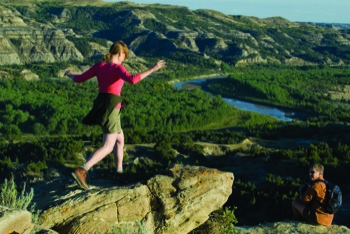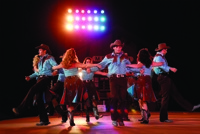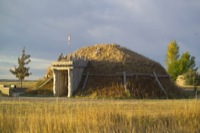
Courtesy North Dakota Tourism
Gorgeous overlooks of badlands, mountains and plains occur frequently in North Dakota.
Huge jaws of sharp teeth, Native American lances and rifles from early settlers prove that North Dakota’s history hasn’t always been peaceful. Museums, parks and other attractions in North Dakota chronicle life in the state from the early days of the dinosaurs to the settlement of the region.
Singing Medora cowboys
To salute the legacy of Theodore Roosevelt, Native American culture and Western heritage, the Medora Musical presents a high-energy show of song, dance and comedy.
“The stage is in an outdoor amphitheater nestled right into the badlands,” said Annette Shilling, marketing and public relations director of the Theodore Roosevelt Foundation. “It has a beautiful backdrop of striated rocks and buttes. With a dark sky, the stars really stand out beautifully.”
 |
| Courtesy North Dakota Tourism |
The 2,852-seat Burning Hills Outdoor Amphitheater runs the patriotic show nightly from June through September with fireworks, Western music, acrobats and comedy acts.
Nearby, all the rodeos, ranching and horseback riding involved in the cowboy lifestyle lives on at the North Dakota Cowboy Hall of Fame. Exhibits on Western culture, videos, and artifacts like Sitting Bull’s headdress and Roosevelt’s rifle help separate myth from reality.
At the Hall of Honorees, displays of prominent North Dakota cowboys tell the stories of characters such as the Marquis de Mores, a cattleman who originally settled the area. Other exhibits that reach further back in history present ancient fossils up to 60 million years old from paleontology digs.
Medora is the gateway to the Theodore Roosevelt National Park, where wildlife watching coexists with historical opportunities at the South Unit’s Maltese Cross Cabin and the North Unit’s Elkhorn Ranch Site. These original cabins, used by Roosevelt as his wilderness retreat, are preserved just as the outdoors-loving president left them before starting down the road to the White House.
“You can stand on his porch and see everything he would have seen down to the creek and cottonwood trees described in his journal,” said Shilling. “It really brings history to a new level of understanding when you can see it and feel it.”
National Historic Sites
Two impressive National Historic Sites interpret the stories of both early fur traders and Native Americans at Knife River Indian Villages in Stanton and the Fort Union Trading Post in Williston.
Knife River Indian Villages is the only national park site devoted to preserving the Northern Plains Indian Heritage. The span of 11,000 years when the Hidatsa and Mandan tribes roamed the area comes into focus at the visitors center’s 15-minute orientation film and museum.
 |
| Courtesy North Dakota Tourism |
“Programs are usually based around daily life in the earth lodge,” said Dorothy Cook, interpretive park ranger for the site. “It is furnished as if the Native Americans were still living in it. Whoever does the program makes sure it ties into the history of the Hidatsa and Mandan tribes.”
Canopy beds, weapons, fire pits and a cache pit, where crops like squash, beans and corn were stored, visually depict the tribes’ daily existence. Visitors can also wander along a one-and-a-half-mile trail down the Knife River past the Earth Lodge Village with interpretive signs along the way.
To illustrate how the local Native Americans interacted with the early fur traders, the Fort Union Trading Post National Historic Site chronicles the fur trade from 1828 to 1867 between the American Fur Co. and the Assiniboine, Crow and Blackfeet tribes.
The reconstructed Indian Trade House displays reproduced items bartered with the Indians, such as beads, buffalo robes, knives and cookware. Some of the items are available for purchase.
Many of the bastions and other buildings have also been reconstructed, such as the Bourgeois House, or superintendent’s house, which now serves as a visitors center and museum. A one-mile hike on the Bodmer Overlook Trail offers a great view of the entire fort, as well as chances to look for wildlife and wildflowers.
Embark to Bismarck
Bismarck, the state capital, contains its fair share of historical attractions, such as those at the North Dakota Heritage Center.
Skeletons of dromaeosaurus, a close relative of Jurassic Park’s famed velociraptors, and plioplatecarpus, dangerous predator of the sea, hang poised in attack mode at the museum, which covers more than 100 million years.
Films, dioramas of homesteaders and interactive exhibits, including cranking a Model T or smelling a buffalo wallow, help engage visitors in a variety of cultures relating to the state.
Lewis and Clark
Because Lewis and Clark once journeyed through the city on their way west, the town showcases a number of attractions related to the duo, such as Keelboat Park. A 55-foot full-scale keelboat docks in the park to replicate Lewis and Clark’s mode of transportation along the river. The outdoor park features a self-guided walking tour that gives facts about the expedition.
In nearby Washburn, information about the pair is also provided at the Lewis and Clark Interpretive Center, which offers an overview of the entire expedition and a special focus on the winter of 1804-1805 in North Dakota.
Guests looking to experience Native American culture can try on a buffalo robe to feel its warmth or a cradleboard that Sacajawea, Lewis and Clark’s native guide, would have worn to carry her baby.
Watercolor paintings by Karl Bodmer, who explored the North Dakota plains in the mid-19th century, serve as the closest thing to photographs of the period.
Researching your Trip:
North Dakota
Department of Tourism
(800) 435-5663
www.ndtourism.com
More Destination Dakotas:
South Dakota
The Badlands










